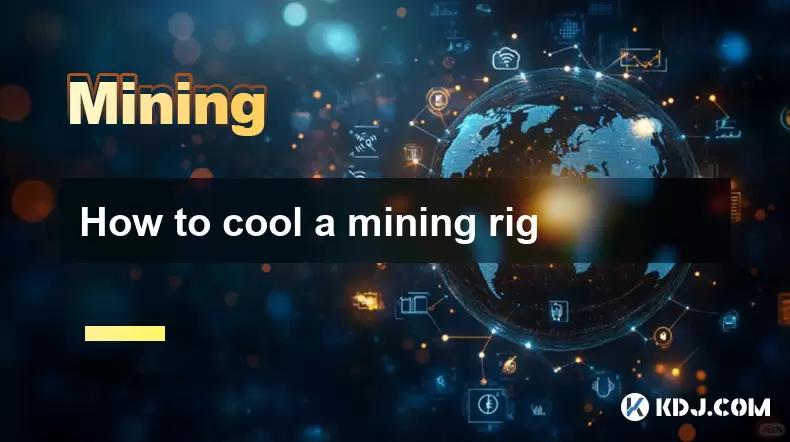-
 bitcoin
bitcoin $99177.955738 USD
-7.32% -
 ethereum
ethereum $3187.183061 USD
-12.38% -
 tether
tether $0.999809 USD
0.00% -
 xrp
xrp $2.117933 USD
-9.42% -
 bnb
bnb $906.710033 USD
-9.17% -
 solana
solana $149.367737 USD
-10.74% -
 usd-coin
usd-coin $0.999816 USD
0.01% -
 tron
tron $0.281498 USD
-0.38% -
 dogecoin
dogecoin $0.156292 USD
-8.00% -
 cardano
cardano $0.500744 USD
-10.19% -
 hyperliquid
hyperliquid $38.087358 USD
-4.58% -
 chainlink
chainlink $14.097831 USD
-8.54% -
 bitcoin-cash
bitcoin-cash $463.329916 USD
-9.22% -
 ethena-usde
ethena-usde $0.999078 USD
-0.01% -
 unus-sed-leo
unus-sed-leo $9.475862 USD
-0.79%
How to cool a mining rig
Proper cooling is essential for mining rigs to prevent overheating, ensure optimal performance, and extend hardware lifespan.
Jul 14, 2025 at 03:07 pm

Understanding the Importance of Cooling in Mining Rigs
Mining rigs generate a significant amount of heat due to continuous operation and high-performance hardware components. This heat, if not managed properly, can lead to thermal throttling, reduced efficiency, and even permanent damage to the mining equipment. Proper cooling ensures optimal performance, longevity of hardware, and consistent mining output. It is essential to understand that different types of mining rigs — whether GPU-based or ASIC — may require varying cooling strategies.
Ambient Temperature and Environmental Considerations
The surrounding environment where the mining rig operates plays a crucial role in its thermal management. Ideally, the room housing the mining rig should have a stable ambient temperature below 25°C (77°F). High humidity levels can also cause condensation and corrosion on sensitive electronics. Ensuring proper ventilation and using air conditioning or dehumidifiers can help maintain an optimal climate for mining operations.
- Position the mining rig away from direct sunlight or heat sources.
- Ensure there is enough space around the rig for air circulation.
- Use exhaust fans or HVAC systems to regulate indoor temperatures.
Optimizing Airflow with Fans and Ventilation
Effective airflow management is one of the most cost-efficient ways to cool a mining rig. Most mining rigs come equipped with internal case fans, but additional external fans can significantly improve heat dissipation. Using intake and exhaust fans strategically helps create a controlled airflow path that pulls cool air in and pushes hot air out.
- Install intake fans at the front of the mining frame or case to draw in cooler air.
- Place exhaust fans at the rear or top to expel warm air.
- Use fan controllers or BIOS settings to adjust fan speeds based on temperature thresholds.
- Clean filters and fan blades regularly to prevent dust buildup that restricts airflow.
Upgrading Hardware for Better Thermal Performance
Sometimes, stock cooling solutions are insufficient for high-intensity mining workloads. Upgrading to better-performing fans, heatsinks, or even liquid cooling systems can make a noticeable difference. GPU miners, in particular, benefit from aftermarket cooling solutions such as larger heatsinks or custom fan shrouds.
- Replace stock fans with higher CFM (cubic feet per minute) models for more powerful airflow.
- Apply high-quality thermal paste between the GPU die and heatsink to enhance heat transfer.
- Consider water-cooling setups for extreme overclocking or multi-GPU configurations.
- Use riser cable extensions to allow vertical GPU mounting for improved spacing and cooling.
Monitoring Temperatures and Adjusting Settings
Regularly monitoring component temperatures is essential to ensure cooling efforts are effective. Software tools like MSI Afterburner, HWMonitor, or mining-specific dashboards provide real-time data on GPU temperatures, fan speeds, and power consumption. Adjusting mining software settings or undervolting GPUs can reduce heat generation without sacrificing much performance.
- Set up alerts or scripts to notify when temperatures exceed safe thresholds.
- Experiment with undervolting to lower power draw and heat output.
- Tune fan curves so that fans ramp up speed gradually with increasing temperatures.
- Avoid running multiple high-intensity applications alongside mining software to minimize load.
FAQ: Frequently Asked Questions About Cooling Mining Rigs
Q: Can I use open-air GPU coolers for mining rigs?Yes, open-air coolers can be beneficial in multi-GPU setups as they blow heat away from adjacent cards rather than into the case. However, they might collect more dust and may not perform as well in dusty environments.
Q: Is it safe to mine in a closed cabinet or enclosed space?Mining in an enclosed space without proper ventilation can lead to overheating. If you must use a cabinet, ensure it has adequate airflow, cooling fans, and temperature monitoring to avoid thermal issues.
Q: How often should I clean my mining rig’s cooling system?It's recommended to clean your mining rig every 2–4 weeks depending on environmental dust levels. Dust buildup on fans and heatsinks reduces cooling efficiency and increases operating temperatures.
Q: Do mining-specific motherboards offer better cooling features?Many mining motherboards come with reinforced PCIe slots and support for multiple GPUs, but their cooling features are generally standard. Additional cooling modifications are usually necessary for sustained mining operations.
Disclaimer:info@kdj.com
The information provided is not trading advice. kdj.com does not assume any responsibility for any investments made based on the information provided in this article. Cryptocurrencies are highly volatile and it is highly recommended that you invest with caution after thorough research!
If you believe that the content used on this website infringes your copyright, please contact us immediately (info@kdj.com) and we will delete it promptly.
- Altcoins, Revenue, and Market Drops: Navigating the Crypto Seas
- 2025-11-06 05:15:01
- Crypto Presales: Navigating Market Bleeding and Finding the Best Investments
- 2025-11-06 04:35:01
- Metaplanet's Bold Bitcoin Bet: Corporate Credit and the Future of Treasury Strategies
- 2025-11-06 04:50:02
- Litecoin, Price Predictions, and the Bitcoin Peak: What's a New Yorker to Do?
- 2025-11-06 05:40:01
- From Coin Flips to Customer Interactions: The Unpredictable World of Games and Retail
- 2025-11-06 04:55:01
- Coins, Crypto Presales, and a Buzzing Mosquito: What's Hot in 2025
- 2025-11-06 05:10:01
Related knowledge

What is the block reward in mining?
Nov 06,2025 at 12:35am
Understanding Block Rewards in Cryptocurrency Mining1. The block reward is the incentive miners receive for successfully validating and adding a new b...

How do mining algorithms work?
Nov 06,2025 at 04:59am
Mining Algorithms and Their Role in Blockchain Networks1. Mining algorithms serve as the backbone of blockchain consensus mechanisms, ensuring that tr...

Does an antivirus program affect mining?
Nov 05,2025 at 09:29pm
Understanding Decentralized Exchanges in the Crypto Ecosystem1. Decentralized exchanges (DEXs) operate without a central authority, allowing users to ...

What is the history of Bitcoin mining?
Nov 05,2025 at 08:15pm
Within the fast-moving world of cryptocurrency, new developments emerge daily, reshaping how investors, developers, and institutions interact with dig...

How is the energy consumption of mining justified?
Nov 05,2025 at 10:20pm
Energy Consumption in Cryptocurrency Mining1. The energy consumption associated with cryptocurrency mining has drawn significant attention from enviro...

What are the main components of a mining rig?
Nov 05,2025 at 08:09pm
Main Components of a Mining Rig1. A mining rig consists of several essential hardware components designed to solve complex cryptographic equations req...

What is the block reward in mining?
Nov 06,2025 at 12:35am
Understanding Block Rewards in Cryptocurrency Mining1. The block reward is the incentive miners receive for successfully validating and adding a new b...

How do mining algorithms work?
Nov 06,2025 at 04:59am
Mining Algorithms and Their Role in Blockchain Networks1. Mining algorithms serve as the backbone of blockchain consensus mechanisms, ensuring that tr...

Does an antivirus program affect mining?
Nov 05,2025 at 09:29pm
Understanding Decentralized Exchanges in the Crypto Ecosystem1. Decentralized exchanges (DEXs) operate without a central authority, allowing users to ...

What is the history of Bitcoin mining?
Nov 05,2025 at 08:15pm
Within the fast-moving world of cryptocurrency, new developments emerge daily, reshaping how investors, developers, and institutions interact with dig...

How is the energy consumption of mining justified?
Nov 05,2025 at 10:20pm
Energy Consumption in Cryptocurrency Mining1. The energy consumption associated with cryptocurrency mining has drawn significant attention from enviro...

What are the main components of a mining rig?
Nov 05,2025 at 08:09pm
Main Components of a Mining Rig1. A mining rig consists of several essential hardware components designed to solve complex cryptographic equations req...
See all articles










































































